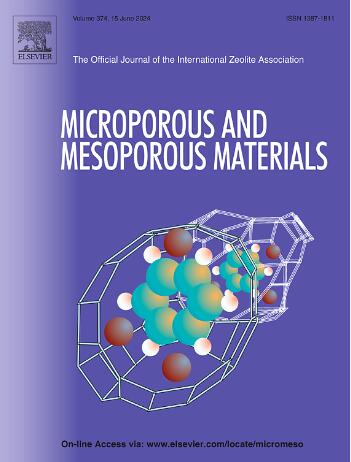Highly porous and chemically stable covalent organic frameworks with designable vertex skeletons for enhanced gas capture
IF 4.7
3区 材料科学
Q1 CHEMISTRY, APPLIED
引用次数: 0
Abstract
Covalent organic frameworks (COFs) represent a class of porous crystalline materials distinguished by their exceptionally high surface areas and well-defined ordered structures. Constructed from organic molecules interconnected through covalent bonds, COFs possess precisely tunable pore sizes, shapes, and functional groups, making them highly versatile candidates for gas capture applications. In this study, two vertex units were designed and incorporated into imine-based COF frameworks to construct highly conjugated structures, achieving exceptional porosity with a BET surface area of up to 1810 m2/g. Moreover, the synthesized COFs demonstrate remarkable chemical stability under extreme acidic and basic conditions. Notably, the resulting TB-COFs exhibit exceptional propane uptake of 197.2 cm3/g and iodine adsorption capacity of 5.6 g/g, positioning them among the top-performing COFs reported to date. These outstanding adsorption performances are attributed primarily to the large accessible surface area and strong affinity between the COF frameworks and iodine molecules.

高度多孔和化学稳定的共价有机框架与可设计的顶点骨架增强气体捕获
共价有机骨架(COFs)是一类多孔晶体材料,其特点是具有极高的表面积和良好的有序结构。COFs由通过共价键连接的有机分子构成,具有精确可调的孔径,形状和官能团,使其成为气体捕获应用的高度通用的候选者。在这项研究中,设计了两个顶点单元,并将其整合到亚胺基COF框架中,以构建高度共轭的结构,实现了非凡的孔隙率,BET表面积高达1810 m2/g。此外,合成的COFs在极端酸性和碱性条件下均表现出良好的化学稳定性。值得注意的是,所得到的TB-COFs具有197.2 cm3/g的丙烷吸收率和5.6 g/g的碘吸附能力,使其成为迄今为止报道的性能最好的COFs之一。这些优异的吸附性能主要归功于COF骨架与碘分子之间的大可达表面积和强亲和力。
本文章由计算机程序翻译,如有差异,请以英文原文为准。
求助全文
约1分钟内获得全文
求助全文
来源期刊

Microporous and Mesoporous Materials
化学-材料科学:综合
CiteScore
10.70
自引率
5.80%
发文量
649
审稿时长
26 days
期刊介绍:
Microporous and Mesoporous Materials covers novel and significant aspects of porous solids classified as either microporous (pore size up to 2 nm) or mesoporous (pore size 2 to 50 nm). The porosity should have a specific impact on the material properties or application. Typical examples are zeolites and zeolite-like materials, pillared materials, clathrasils and clathrates, carbon molecular sieves, ordered mesoporous materials, organic/inorganic porous hybrid materials, or porous metal oxides. Both natural and synthetic porous materials are within the scope of the journal.
Topics which are particularly of interest include:
All aspects of natural microporous and mesoporous solids
The synthesis of crystalline or amorphous porous materials
The physico-chemical characterization of microporous and mesoporous solids, especially spectroscopic and microscopic
The modification of microporous and mesoporous solids, for example by ion exchange or solid-state reactions
All topics related to diffusion of mobile species in the pores of microporous and mesoporous materials
Adsorption (and other separation techniques) using microporous or mesoporous adsorbents
Catalysis by microporous and mesoporous materials
Host/guest interactions
Theoretical chemistry and modelling of host/guest interactions
All topics related to the application of microporous and mesoporous materials in industrial catalysis, separation technology, environmental protection, electrochemistry, membranes, sensors, optical devices, etc.
 求助内容:
求助内容: 应助结果提醒方式:
应助结果提醒方式:


